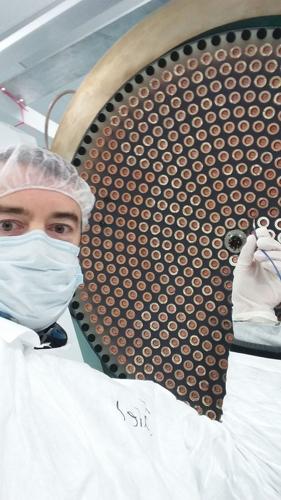Astronomer Jared Males has already captured images of giant, hot exoplanets around fairly distant stars.
Now he’s aiming at a closer, much tougher target: Proxima b, the recently discovered, rocky planet that orbits our nearest star, Proxima Centauri, about 4.25 light years away.
First he has to build a new instrument, which the National Science Foundation just gave him $2.3 million to do. Then he has to persuade the developers of a giant telescope to let him build an even bigger version of it for them.
It’s a long-range plan and Males expects to make discoveries along the way.
Males was just appointed this summer to the faculty of the University of Arizona’s department of astronomy and Steward Observatory.
He earned his doctorate at the UA, helping astronomy professor Laird Close build and deploy an adaptive optics system that erases the aberrations caused by Earth’s atmosphere on the 6.5-meter Magellan Clay Telescope in Chile. The MagAO team has since imaged eight exoplanets in visible light, the first team to do so.
He continued working at UA as a NASA Sagan fellow with astronomer and optical scientist Olivier Guyon, who specializes in coronagraphs, which cancel the light of a star, allowing the much fainter planet to appear.
Close and Guyon are co-investigators on the NSF grant to build an “extreme adaptive optics” instrument that will employ the latest advances in coronagraphy and make adjustments for atmospheric disturbance 3,700 times a second.
“Were taking a pretty powerful system and making it a lot more powerful,” Close said.
Steward astronomers Katie Morzinski and Phil Hinz are also co-investigators.
The instrument will at least triple the resolution quality of the images the MagAO system now takes, Males said.
That will allow the team to target Jupiter-like planets around near and distant stars and refine the system for future exploration of smaller, dimmer planets.
The planets imaged so far by the team are in the process of formation — glowing with heat and light. Upcoming targets will be 10 million times fainter than their stars, said Close.
It is theoretically possible to image dim planets such Proxima b with the new, improved system on the Magellan telescope, said Males, but that feat would test the limits of the system and require about 40 nights of continuous observations.
Proxima b is a tough target. It may be the planet closest to Earth, but it is also very close to its sun and very dim.
It orbits every 11 days at a distance of 4.6 million miles. That would be much too close if its sun were like ours. But Proxima Centauri is a red dwarf — one-eighth the size of our sun and emitting only a fraction of its light and heat.
That puts Proxima b in the habitable zone — with temperatures where liquid water and life could exist.
It is much too close to its host star for current telescope technology — on Earth or in space — to image.
It took a 60-night observing campaign on telescopes across the globe, organized by the European Southern Observatory (ESO) in Chile, to simply verify the planet’s existence by measuring the push and pull of its orbit on its sun. ESO announced its confirmation in August.
Realistically, images of the planet that will provide clues to its makeup and atmosphere will have to wait for development of much larger telescopes than the 10-meter class now in operation, Males said.
Three are planned — the ESO’s 39-meter Extremely Large Telescope in Chile, the Thirty Meter Telescope planned for the island of Hawaii and the 24.5-meter Giant Magellan Telescope being built in Chile.
The Giant Magellan Telescope, whose seven, 8-meter mirrors are being cast and polished at Steward Observatory’s Richard F. Caris Mirror Lab, is best-suited to the instrument being developed by the Steward astronomers.
Males, Guyon and Close recently attended a meeting convened by the GMT to explore the science it could do in the realm of exoplanets. “All anybody wanted to talk about was Proxima b,” Males said.
The “Extreme AO” being built by Males introduces new optical elements into the MagAO system, which is a deformable mirror whose 585 electro-magnetic actuators bend a thin secondary mirror to correct for atmospheric turbulence.
The new instrument will send that light down an additional path. Its heart is a device called a MEMS deformable mirror. MEMS stands for MicroElectroMechanical Systems.
The silicon device can change the shape of a tiny mirror, (three-quarters of an inch in diameter) at 2,000 different points and at speeds up to 10,000 times per second.
“We won’t be able to drive it that fast,” said Males. The speed is limited by another component of the instrument, the wave-front sensor, which measures the aberrations in the atmosphere and sends the signals needed to correct them. It operates at about 3,700 times a second.
The third element of the system is a next-generation coronagraph, whose development is being led by Guyon, who heads a similar effort on the 8.2-meter Subaru Telescope in Hawaii.
Those improvements will be added to the telescope one-by-one over the next three years, Males said.
For now, he is readying his new lab to start building the “visible wavelength extreme-adaptive optics coronagraphic imager.”
Close said winning a “major research instrumentation award” from the National Science Foundation is a pretty good coup for a brand-new professor.
“It was a heck of a start to my new job,” said Males.







